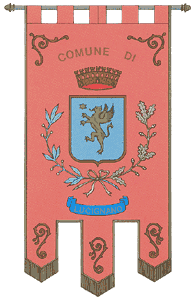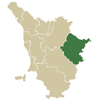|
 Inhabitants in 1991 : 3,349
Inhabitants in 1991 : 3,349
 The Municipal territory of Lucignano, extends for 44,90 square kilometres,
partly hill and partly in the underlying plain, between two tributaries
of the Canale Maestro della Chiana, the stream Esse and the channel Vertege,
and in antique times it was crossed by the Via Cassia Adrianea ;
the capital is situated on the summit of a hill which is part of the ridge
of the Monti di Palazzolo. It was probably a Longobardo settlement,
then a free community and in the end Seat of a Vicariate.
The Municipal territory of Lucignano, extends for 44,90 square kilometres,
partly hill and partly in the underlying plain, between two tributaries
of the Canale Maestro della Chiana, the stream Esse and the channel Vertege,
and in antique times it was crossed by the Via Cassia Adrianea ;
the capital is situated on the summit of a hill which is part of the ridge
of the Monti di Palazzolo. It was probably a Longobardo settlement,
then a free community and in the end Seat of a Vicariate.
Lucignano, claiming to be founded by the Roman family of Licinia,
is noted for the first time in the XI century in some parchments
belonging to the Abbey of Agnano in Val d’Ambra. But its history
is little documented at least until the second half of the 1200 :
one supposes that the little town, in this period, was freely governed,
giving in to indirect domination by Arezzo.
After the battle of Campaldino the victorious Fiorentini left Lucignano,
together with Monte San Savino, under a sort of protectorate by Siena ;
It returned under Arezzo during the first half of the 1300s, in 1336
during the war between Arezzo and Perugia the castle passed to
the community of Perugia. It re-conquered its independence in August
of 1343, but was constricted to submit from the beginning of 1353
to Firenze then in 1370 to Siena ; with the conquest of Arezzo
and its district by the Fiorentina in 1384, Firenze regained possession
of Lucignano, even though it entailed an expenditure of 8,000 gold
florins to Siena. In 1390 it was again conquered by Siena with the help
of the troops of the Gian Galeazzo Visconti, Duke of Milano, Lucignano
began a long dependence to the republic of Siena which held it
for 1½ centuries ; only in 1553 did it come under the authority
of the Mediceo State, who made it capital of a Vicariate which hosted
the resident magistrates alternatively with Monte San Savino.
Places to Visit :
The entire Medieval walled village, which has remained intact to this
day.
Town Hall, 1300 building decorated by stone coats of arms,
with a fresco decorated interior. Some of the rooms are adapted to
the Corporation Museum, in which is exhibited the Albero
di Lucignano and enormous reliquary in the form of a tree, the
work of goldsmiths from Siena.
S . Francesco, 1300 church with Roman facade with divisions
in grey and white , has an Egyptian cross interior. The works
of art within are noteworthy.
S. Michele Arcangelo, collegiate in1594 admirably inserted
in the urban context
Madonna delle Querce, Sanctuary going back to the second half
of the 1500s, built on a design by Vasari. |
Historical info reproduced upon authorization of Regione Toscana - Dipartimento della Presidenza E Affari Legislativi e Giuridici
Translated by Ann Mountford
|